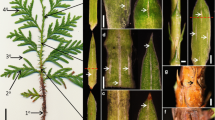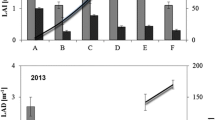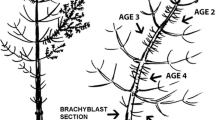Abstract
We determined variation in both the concentration and composition of terpenoids in needles and wood within nine Scots pine (Pinus sylvestris) provenances. Seedlings of different provenances representing a 1200-km N–S transect from Estonia to northern Finland were cultivated in Suonenjoki nursery field, central Finland, for seven years. Growth of seedlings and the number of vertical resin ducts in wood were also determined. α-Pinene and 3-carene were the major monoterpenes both in the needles and wood. The total monoterpene concentration was about five times higher in the needles than in the wood. A strong positive correlation was found between proportional quantities of several terpenes of the needles and wood, particularly for 3-carene, sabinene, and terpinolene. The needles contained both labdane-type and tricyclic resin acids, whereas the wood contained only tricyclic ones. The wood had a four times higher tricyclic resin acid concentration than the needles. The highest total monoterpene concentration in the needles and in the wood occurred in the most northern Muonio provenance and in the most southern Saaremaa provenance plants, respectively. The amount of high 3-carene genotype trees decreased among the northern provenances. The wood of the most northern Muonio provenance showed the lowest total resin acid concentration, but provenance did not affect total tricyclic resin acids in the needles. Korpilahti provenance trees from central Finland had the best growth in height. In addition, Korpilahti and Ruokolahti provenance trees showed largest radial growth of stem and smallest number of vertical resin ducts. The results suggest that especially the proportional quantity of 3-carene in the needles could be used in estimating the amount of this compound in the wood and vice versa.
Similar content being viewed by others
REFERENCES
Andersson, R., Gref, R., and Lundgren, L.N. 1990. Manoyl oxide acid from resin of Pinus sylvestris needles. Phytochemistry 29:1320–1322.
Baradat, P. H. and Yazdani, R. 1988. Genetic expression for monoterpenes in clones of Pinus sylvestris grown on different sites. Scand. J. For. Res. 3:25–36.
Blanche, C. A., Lrio, P. L., Jr, Sommers, R. A., Hodges, J. D., and Nebeker, T. E. 1992. Seasonal cambial growth and development of loblolly pine: Xylem formation, inner bark chemistry, resin ducts, and resin flow. For. Ecol. Manage. 49:151–165.
Bridgen, M. R. and Hanover, J. W. 1982. Genetic variation in oleoresin physiology of Scotch pine. For. Sci. 28:582–589.
Bridges, J. B. 1987. Effects of terpenoid compounds on growth of symbiotic fungi associated with the southern pine beetle. Phytopathology 77:83–85.
Chalchat, J.-C., Garry, R.-P., Michet, A., and Remery, A. 1985. The essential oils of two chemotypes of Pinus sylvestris. Phytochemistry 24:2443–2444.
Coppen, J. J. W., Gay, C., James, D. J., Robinson, J. M., and Mullin, L. J. 1993. Xylem resin composition and chemotaxonomy of three varieties of Pinus caribaea. Phytochemistry 33:1103–1111.
Cown, D. J., Young, G. D., and Burdon, R. D. 1992. Variation in wood characteristics of 20-year-old half-sib families of Pinus radiata. N. Z. J. For. Sci. 22:63–76.
Danell, K., Gref, R., and Yazdani, R. 1990. Effects of mono-and diterpenes in Scots pine needles on moose browsing. Scand. J. For. Res. 5:535–539.
Davies, N. W. 1990. Gas chromatographic retention indices of monoterpenes and sesquiterpenes on methyl silicone and Carbowax 20M phases. J. Chromatogr. 503:1–24.
Elias, V. O., Simoneit, B. R. T., and Cardoso, J. N. 1997. Analysis of volatile sesquiterpenoids in environmental and geological samples. J. High Resolut. Chromatogr. 20:305–309.
Esau, K. 1977. Anatomy of Seed Plants, 2nd ed. John Wiley & Sons, New York.
Gershenzon, J. and Croteau, R. 1991. Terpenoids, pp. 165–219, in G. A. Rosenthal and M. R. Berenbaum (eds.). Herbivores, Their Interactions with Secondary Plant Metabolites, Vol. 1, The Chemical Participants. Academic Press, New York.
Gleizes, M., Pauly, G., Bernard-Dagan, C., and Jacques, R. 1980. Effects of light on terpene hydrocarbon synthesis in Pinus pinaster. Physiol. Plant 50:16–20.
Gref, R. 1987. Resin acids and resistance of Pinus sylvestris to Melampsora pinitorqua. Eur. J. For. Pathol. 17:227–230.
Gref, R. and Ericsson, A. 1985. Wound-induced changes of resin acid concentrations in living bark of Scots pine seedlings. Can. J. For. Res. 15:92–96.
Gref, R. and Tenow, O. 1987. Resin acid variation in sun and shade needles of Scots pine (Pinus sylvestris L.). Can. J. For. Res. 17:346–349.
Hansson, L. and Gref, R. 1987. Bark chemistry of Pinus contorta and P. sylvestris in relation to vole damage. Scand. J. For. Res. 2:359–363.
Herms, D. A. and Mattson, W. J. 1992. The dilemma of plants: To grow or defend. Q. Rev. Biol. 67:283–335.
Hiltunen, R., Tigerstedt, P. M. A., Juvonen, S., and Pohjola, J. 1975. Inheritance of 3-carene quantity in Pinus silvestris L. Farm. Aikak. 84:69–72.
Hrutfiord, B. F., Hopley, S. M., and Gara, R. I. 1974. Monoterpenes in Sitka spruce: Within tree and seasonal variation. Phytochemistry 13:2167–2170.
Juvonen, S. and Hiltunen, R. 1972. Über das Vorkommen von 3-Caren-armen und-reichen Chemotypen bei Pinus silvestris L. in Finnland. Biogenetische Studien II. Farm. Aikak. 81:137–145.
Kainulainen, P., Holopainen, J., PalomÄki, V., and Holopainen, T. 1996. Effects of nitrogen fertilization on secondary chemistry and ectomycorrhizal state of Scots pine seedlings and on growth of grey pine aphid. J. Chem. Ecol. 22:617–636.
Kleinhentz, M., Jactel, H., and Menassieu, P. 1999. Terpene attractant candidates of Dioryctria sylvestrella in maritime pine (Pinus pinaster) oleoresin, needles, liber, and headspace samples.J. Chem. Ecol. 25:2741–2756.
Klepzig, K. D., Smalley, E. B., and Raffa, K. F. 1996. Combined chemical defenses against an insect-fungal complex. J. Chem. Ecol. 22:1367–1388.
Larsson, S., BjÖ rkman, C., and Gref, R. 1986. Responses of Neodiprion sertifer (Hym., Diprionidae) larvae to variation in needle resin acid concentration in Scots pine. Oecologia 70:77–84.
Latta, R. G., Linhart, Y. B., Lundquist, L., and Snyder, M. A. 2000. Patterns of monoterpene variation within individual trees in ponderosa pine. J. Chem. Ecol. 26:1341–1357.
Leather, S. R. 1987. Pine monoterpenes stimulate oviposition in the pine beauty moth, Panolis flammea. Entomol. Exp. Appl. 43:295–297.
Lewinsohn, E., Gijzen, M., Savage, T. J., and Croteau, R. 1991. Defence mechanisms of conifers: Relationship of monoterpene cyclase activity to anatomical specialization and oleoresin monoterpene content. Plant Physiol. 96:38–43.
Manninen, A.-M. 1999. Susceptibility of Scots pine seedlings to specialist and generalist insect herbivores—Importance of plant defence and mycorrhizal status.Kuopio University Publications C. Natural and Environmental Sciences 100.
Manninen, A.-M., Holopainen, T., and Holopainen, J. K. 1998a. Susceptibility of ectomycorrhizal and non-mycorrhizal Scots pine (Pinus sylvestris) seedlings to a generalist insect herbivore, Lygus rugulipennis, at two nitrogen availability levels. New Phytol. 140:55–63.
Manninen, A.-M., Vuorinen, M., and Holopainen, J. K. 1998b. Variation in growth, chemical defense, and herbivore resistance in Scots pine provenances. J. Chem. Ecol. 24:1315–1331.
Manninen, A.-M., Holopainen, T., LyytikÄinen-Saarenmaa, P., and Holopainen, J. K. 2000.The role of low-level ozone exposure and mycorrhizas in chemical quality and insect herbivore performance on Scots pine seedlings. Glob. Change Biol. 6:111–121.
McCullough, D. G. and Kulman, H. M. 1991. Effects of nitrogen fertilization on young jack pine (Pinus banksiana) and on its suitability as a host for jack pine budworm (Choristoneura pinus pinus) (Lepidoptera: Tortricidae). Can. J. For. Res. 21:470–475.
Muona, O., Hiltunen, R., Shaw, D. V., and MorÉn, E. 1986. Analysis of monoterpene variation in natural stands and plustrees of Pinus sylvestris in Finland. Silva Fenn. 20:1–8.
Nerg, A., Kainulainen, P., Vuorinen, M., Hanso, M., Holopainen, J. K., and Kurkela, T. 1994. Seasonal and geographical variation of monoterpenes, resin acids and total phenolics in nursery grown Scots pine (Pinus sylvestris L.) seedlings. New Phytol. 128:703–713.
Paine, T. D. and Hanlon, C. C. 1994. Influence of oleoresin constituents from Pinus ponderosa and Pinus jeffreyi on growth of mycangial fungi from Dendroctonus ponderosae and Dendroctonus jeffreyi. J. Chem. Ecol. 20:2551–2563.
Phillips, M. A. and Croteau, R. B. 1999. Resin-based defenses in conifers. Trends Plant Sci. 4:184–190.
Rafii, Z. A., Dodd, R. S., and Zavarin, E. 1996. Genetic diversity in foliar terpenoids among natural populations of european black pine. Biochem. Syst. Ecol. 24:325–339.
Repo, T., Zhang, G., RyyppÖ, A., Rikala, R., and Vuorinen, M. 2000. The relation between growth cessation and frost hardening in Scots pines of different origins. Trees 14:456–464.
Saikkonen, K., Neuvonen, S., and Kainulainen, P. 1995. Oviposition and larval performance of European pine sawfly in relation to irrigation, simulated acid rain and resin acid concentration in Scots pine. Oikos 74:273–282.
Sallas, L., Vuorinen, M., Kainulainen, P., and Holopainen, J. K. 1999. Effects of planting on concentrations of terpenes, resin acids and total phenolics in Pinus sylvestris seedlings. Scand. J. For. Res. 14:218–226.
SjÖdin, K., Persson, M., and Norin, T. 1993. Enantiomeric compositions of monoterpene hydrocarbons in the wood of healthy and top-cut Pinus sylvestris. Phytochemistry 32:53–56.
SjÖdin, K., Persson, M., Borg-Karlson, A.-K., and Norin, T. 1996. Enantiomeric compositions of monoterpene hydrocarbons in different tissues of four individuals of Pinus sylvestris. Phytochemistry 41:439–445.
SjÖdin, K., Persson, M., FÄldt, J., Ekberg, I., and Borg-Karlson, A.-K. 2000. Occurrence and correlations of monoterpene hydrocarbon enantiomers in Pinus sylvestris and Picea abies.J. Chem. Ecol. 26:1701–1720.
Tobolski, J. J. and Zinkel, D. F. 1982. Variation in needle and cortex resin acids during shoot development in Pinus sylvestris, P. nigra, and P. strobus. For. Sci. 28:785–796.
Tognetti, R., Michelozzi, M., and Giovannelli, A. 1997. Geographical variation in water relations, hydraulic architecture and terpene composition of Aleppo pine seedlings from Italian provenances. Tree Physiol. 17:241–250.
ValterovÁ, I., SjÖdin, K., Vrkoc, J., and Norin, T. 1995. Contents and enantiomeric compositions of monoterpene hydrocarbons in xylem oleoresins from four Pinus species growing in Cuba. Comparison of trees unattacked and attacked by Dioryctria horneana. Biochem. Syst. Ecol. 23: 1–15.
Walter, J., Charon, J., Marpeau, A., and Launay, J. 1989. Effects of wounding on the terpene content of twigs of maritime pine (Pinus pinaster Ait.) I. Changes in the concentration of diterpene resin acids and ultrastructural modifications of the resin duct epithelial cells following injury. Trees 4:210–219.
Wilson, K. and White, D. J. B. 1986. The Anatomy ofWood: Its Diversity and Variability. Stobart & Son, London, England.
Yazdani, R. and Nilsson, J.-E. 1986. Cortical monoterpene variation in natural populations of Pinus sylvestris in Sweden. Scand. J. For. Res. 1:85–93.
Yazdani, R., Rudin, D., AldÉn, T., Lindgren, D., Harbom, B., and Ljung, K. 1982. Inheritance pattern of five monoterpenes in Scots pine (Pinus sylvestris L.). Hereditas 97:261–272.
Author information
Authors and Affiliations
Rights and permissions
About this article
Cite this article
Manninen, AM., Tarhanen, S., Vuorinen, M. et al. Comparing the Variation of Needle and Wood Terpenoids in Scots Pine Provenances. J Chem Ecol 28, 211–228 (2002). https://doi.org/10.1023/A:1013579222600
Issue Date:
DOI: https://doi.org/10.1023/A:1013579222600




